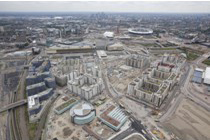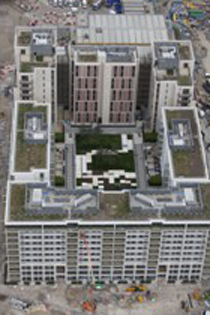
Olympic social housing, by Valentina Carpitella |
 |
Alongside the International media re-launch of London and the planning and control on quality building for environmental sustainability, the 2012 London Olympic Games programme intends to offer housing for Londoners in the lower wage bracket, paying particular attention to the global sustainability of the interventions. This policy risks going into crisis following the failure of some building development projects defined in the Olympic masterplan. The biggest risk is connected to the chain effect started by the current economic crisis. In fact the total development plan includes both a very high quota of residential housing situated outside the Olympic village: a social economic re-launch, but also construction in a target area, characterised by negative parameters and long term criticism.
The idea is to transform this urban area in decline, that of Stratford, east of London, into a new propulsive centre for the urban area and the city; a hypothesis which is not new but the fruit of a long planning and programming process, which has found its catalyzing moment in the big event, collectively seen today as a symbol of the revival of a European capital city. The attention to social inclusion is shown by the involvement of the lower wage bracket population through the action of private and mixed structures which according to the English tradition contribute to the creation of social residential housing.
The project is situated in a vaster development plan within a strategic framework of regeneration, built on a few key themes to be carried out through social policies, centred on local authorities and redefining the economic profile of the area. The intention is to insert a portion of territory into the more complex urban development, through an attractive functional mix of quality housing, green areas, new connections and areas which are highly suitable for living.
The Olympic village will host 17000 athletes during the Games who will have every type of equipment at their disposal as well as an efficient system of transport; after the Olympics it will become a residential area characterised by strongly differentiated housing typologies and by a heterogeneous population. There will be 2800 houses on the whole, 1380 of which will be destined for social housing. Triathlon Homes, which will control the management of these latter, has signed an agreement with the Olympic Delivery Authority to acquire the 1380 units through subventions from the Homes and Communities Agency and bank loans. The housing patrimony, characterised by a cut in variable accommodation, is qualified by high environmental standards, energy savings and by a close relationship with open spaces.
The social housing will include reduced rates and/or be subject to different models of allocation, insuring the presence of inhabitants with different characteristics and equal conditions of access.
It is not a new policy. It is sufficient to look at Italy and the Olympic Village in Rome, which includes sports facilities which are still in use today and the athletes village. In Rome, the beautiful sports facilities are still in use but the quarter, which was originally built in an area of urban expansion, has only become central recently, after the creation of the Auditorium Parco della Musica, with the structuring of a complex urban system which was developed over different periods. A successful example made through fragmented actions which without relying on innovative instruments has undergone, in its own time, urban transformations leading to the construction of a part of the city which has acquired sense. Even in the case of the Winter Olympics in Turin, much more recently, we find the offer of beds for athletes and houses for people; however we must ask ourselves how this transformation in use generally accompanies a greater social inclusion and processes of larger urban development.
In the case of London, it is much more complex: the multiple uses of the sports facilities, to be completely or partly recuperated after the games; more sophisticated management/acquisition procedures of housing. The future quarter has already been planned for its new inhabitants, with services and above all schools.
The consolidated tradition in the field of management and urban regeneration makes the London case an example of virtuous planning. However there is a high risk of creating a Stratford for the rich, expelling the low wage bracket population because of the increased living costs which are already prohibitive for younger residents.
We may ask ourselves, after such considerations, what space is left for social inclusion during this economic crisis, if housing for a less well-to-do class inserted inside areas of higher value can become an aspect which inhibits private investment or is it a lever for housing development?
The theme opens thinking about the relationship between an economic crisis and policies directed at the positioning of lower classes, and how social housing can become a stimulus for economic development in a country and not just a policy directed at social inclusion.
Conciliating investment in social housing and economic development is possible by imagining this type of accommodation as a solution to the problems of the population and at the same time actions directed at housing development. This is the road which has been taken by Great Britain and it can become the one taken by Italy in the area of environmental and social sustainability of interventions and of economic development even in the stagnant building sector, in coincidence with big events but also through actions inserted in the political agenda of the country.



